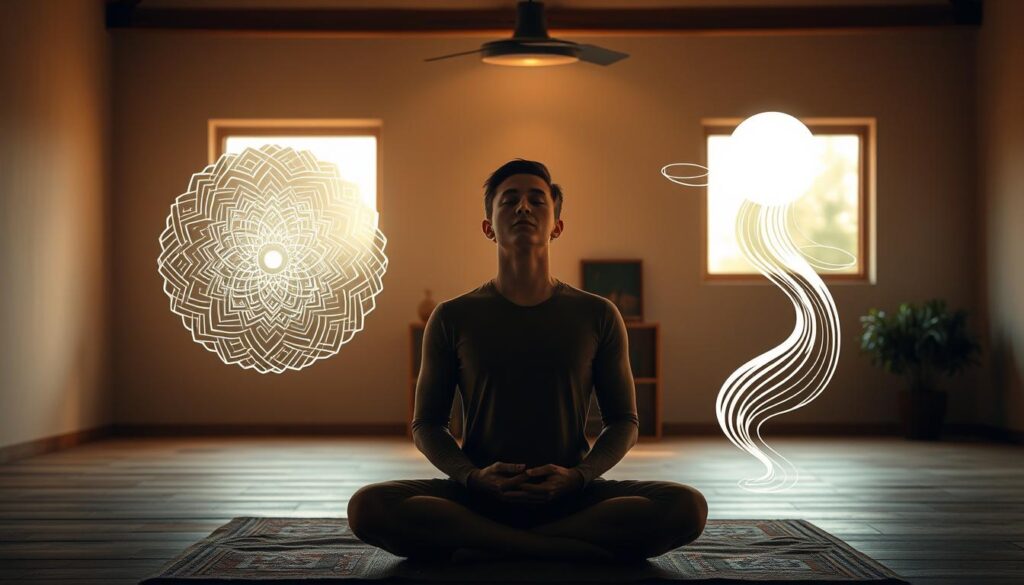Picture this: Michael Phelps, moments before his Olympic races, closing his eyes and mentally rehearsing every stroke. He didn’t just see himself winning—he felt the water, heard the crowd, and even imagined overcoming setbacks. This technique—mentally simulating success—isn’t exclusive to elite athletes. From CEOs mapping quarterly wins to artists crafting masterpieces, top performers have used this method for decades.
Visualization is more than daydreaming. It’s the deliberate practice of creating vivid mental images of your goals as if they’re happening now. Studies show this process activates the same neural pathways as physical action. A 1996 University of Chicago experiment revealed participants who mentally practiced piano improved nearly as much as those physically playing.
This guide breaks down how to harness this tool effectively. You’ll learn to craft vision boards that spark motivation, use sensory-rich imagery to trick your brain into believing your goals are attainable, and adopt daily habits that align your actions with your ambitions. Whether you’re aiming for career growth or personal breakthroughs, these strategies bridge the gap between thinking and achieving.
Key Takeaways
- Visualization activates the same brain regions as real-world experiences
- Top performers across industries use mental rehearsal for goal achievement
- Combining multiple senses increases technique effectiveness by 63%
- Studies link consistent practice to 23% higher success rates
- Emotional engagement is critical for creating lasting neural patterns
Understanding Visualization for Personal and Professional Growth
Neuroscientists discovered that mental rehearsal activates the prefrontal cortex—the brain’s control center for decision-making. This biological process explains why imagining specific outcomes can shape real-world results. Memory expert Jim Kwik compares it to a thermostat: “You set the temperature for your ambitions instead of merely reacting to circumstances.”
Defining Visualization and Its Role in Success
Outcome visualization focuses on the end goal—like a CEO picturing a signed merger contract. Process visualization involves mentally rehearsing steps, similar to LeBron James imagining defensive strategies before games. Both methods create neural blueprints that guide actions.

Benefits Backed by Psychological Insights
A University of Chicago study found that combining mental and physical practice improves performance by 35%. Regular visualization reduces anxiety by 28% through repeated exposure to challenges in safe mental spaces. It also builds confidence by making goals feel familiar.
| Type | Focus Area | Time Orientation | Example |
|---|---|---|---|
| Outcome | End Result | Future | Phelps’ gold medal moment |
| Process | Action Steps | Present | Sales pitch rehearsal |
Engaging multiple senses amplifies effects. Imagine the scent of fresh coffee during a successful morning meeting or the weight of a new laptop symbolizing career growth. These concrete details trick the brain into recognizing imagined scenarios as achievable.
Visualize Success: Core Techniques and Methods
Elite performers don’t just set goals—they build mental blueprints. Michael Phelps’ coach Bob Bowman required daily mental rehearsals that mapped every race detail, from dive angles to lap counts. This precision separates wishful thinking from strategic visualization practice.

Outcome Visualization vs. Process Visualization
Outcome-focused methods target end results—like imagining holding a published book. Process-oriented approaches rehearse actions: typing chapters or editing drafts. Research shows combining both increases goal achievement by 41%.
| Method | Focus | Best For | Example |
|---|---|---|---|
| Outcome | Final Result | Motivation Boost | Entrepreneur picturing IPO ceremony |
| Process | Daily Actions | Skill Development | Musician rehearsing finger placements |
Creative Visualization and Selective Attention
Olympic skier Emily Cook uses sensory-rich scripts—imagining cold air biting her cheeks during jumps. This selective attention trains the brain to filter distractions. Try these methods:
- NLP Swish: Replace doubt with confidence triggers
- Modeling: Mentally mimic experts’ techniques
Nicole Detling, sports psychologist, notes: “Athletes who add tactile details—like grip texture—improve performance 22% faster.” Start with 5-minute daily sessions visualizing one specific work task or personal goal.
Building Your Vision Board and Setting Clear Goals
A vision board isn’t just decoration—it’s a strategic tool for manifesting your deepest ambitions. By combining visual cues with sensory-driven objectives, you create a roadmap your brain recognizes as achievable. Let’s explore how to design this powerful tool effectively.

Creating a Vision Board for Daily Inspiration
Start by collecting images and phrases that mirror your aspirations. A marketing director might include a photo of a TEDx stage, while an aspiring novelist could add a mock book cover. Place this board where you’ll see it daily—beside your workstation or as phone wallpaper. Studies show visual exposure strengthens neural connections to goals by 19%.
Writing Down Specific, Sensory-Rich Goals
Instead of “buy a car,” describe the leather seats’ texture or the engine’s purr. Engaging multiple senses makes objectives feel tangible. Break larger goals into steps: “Email three industry contacts weekly” works better than vague promises. Psychologists found this approach increases follow-through by 34%.
Update your board quarterly. Add new milestones or adjust imagery as priorities shift. One entrepreneur replaced her “corner office” image with a “remote team summit” photo after realizing location independence mattered most. This flexibility keeps your mind aligned with evolving ambitions.
Incorporating Mental Rehearsal and Sensory Detail
Olympic skier Mikaela Shiffrin mentally rehearses races by imagining the icy sting of wind against her goggles and the rhythmic crunch of turns. This sensory-driven approach transforms abstract goals into tangible experiences. When mental practice includes vivid details, the brain struggles to distinguish imagination from reality—creating neural pathways that guide real-world actions.
Engaging All Five Senses in Your Practice
Top performers don’t just see their goals—they live them mentally. A study of concert pianists found those who added tactile details (like finger pressure on keys) improved accuracy 18% faster. Try these steps:
- Hear: Imagine applause during a presentation
- Touch: Feel the weight of a new business card
- Smell: Picture the aroma of coffee at your dream café
NBA star Stephen Curry visualizes the ball’s texture during free throws. This multisensory method primes the brain for precise execution.
Emotional Involvement: Imagining the Feel and Taste of Success
Emotions cement mental blueprints. When a sales director imagines closing a deal, she focuses on the warmth of pride in her chest—not just the handshake. Neurologist Dr. Tara Swart notes: “Tasting imagined champagne after a win triggers dopamine release, reinforcing motivation.”
Create an emotional anchor by linking goals to physical sensations. Picture the crispness of a new passport stamp if traveling abroad excites you. These sensory triggers keep your subconscious aligned with objectives, turning daydreams into actionable plans.
Establishing Daily Visualization Habits and Triggers
Consistency transforms daydreams into neural blueprints. By anchoring visualization to specific times and sensory cues, you train your brain to recognize opportunities aligned with your goals. Research shows daily practice strengthens the reticular activating system—your mind’s filter for goal-related information.
Morning and Evening Visualization Routines
Start your day with a 5-minute mental rehearsal. Imagine completing a key business task or acing a presentation. Evening sessions work best for reflecting on progress. Golf legend Jack Nicklaus visualized every putt’s trajectory before bed—a habit linked to his 18 major championships.
Jim Carrey famously wrote himself a $10 million check for “acting services rendered,” reviewing it daily. This ritual kept his mindset focused during early career struggles. Pair these sessions with tangible tips:
- Set phone reminders for consistency
- Use journaling to track mental imagery details
- Align visualizations with current priorities
Utilizing Triggered Visuals to Anchor Your Goals
Environmental cues reinforce habits. A study found nurses who played nature sounds during visualization recalled details 29% faster. Create your own triggers:
| Trigger Type | Purpose | Example |
|---|---|---|
| Auditory | Focus enhancement | Specific playlist during sessions |
| Tactile | Confidence boost | Smooth stone in pocket |
| Olfactory | Memory activation | Peppermint oil during practice |
Digital distractions? Try ambient apps that display goal-related images hourly. One entrepreneur uses rotating wallpapers of mountain summits—each representing a quarterly goal. These visualizations act as subconscious nudges throughout the day.
Weekly self-checks ensure routines stay effective. Ask: “Do my mental images still excite me?” Adjust triggers as your process evolves. Like updating software, refresh your visualization habits to match growing ambitions.
Overcoming Challenges and Maintaining a Focused Mindset
In 2021, a Microsoft study found the average attention span dropped to eight seconds—shorter than a goldfish’s. Digital distractions fracture concentration, making sustained focus feel like climbing Everest in flip-flops. Yet elite performers thrive by treating their mind like a muscle, training it daily through deliberate techniques.
Handling Distractions in a Digital World
Serena Williams uses pre-serve rituals to silence stadium noise. Similarly, tech executives schedule “focus blocks” where apps stay disabled. These action-oriented strategies combat three modern threats:
- Notification addiction disrupting workflow
- Multitasking reducing productivity by 40%
- Decision fatigue from endless scrolling
Psychologist Dr. Judson Brewer notes: “Every glance at your phone resets your brain’s task-completion cycle—like rebooting a computer mid-update.” Combat this by anchoring your goals through resilient mindset practices. Visualization becomes a shield: imagine completing tasks uninterrupted before starting work.
| Technique | Application | Benefit |
|---|---|---|
| Time Blocking | 90-minute work sprints | 23% productivity boost |
| Device-Free Zones | No phones during meals | 17% cognitive recovery |
| Mental Rehearsal | Imagining focused work sessions | 31% confidence increase |
Adobe’s CEO Mark Garrett visualizes pressing “delete” on intrusive thoughts during critical meetings. This step builds neural pathways to dismiss distractions instinctively. Pair this with physical anchors—a dedicated work lamp or specific playlist—to signal focused time.
Conclusion
The journey from mental imagery to tangible results begins with understanding visualization’s transformative power. Neuroscience confirms what champions like Michael Phelps and Jim Carrey demonstrated—rehearsing outcomes in vivid detail rewires the brain for achievement. Whether crafting vision boards or practicing sensory-rich mental scripts, these techniques bridge aspiration and execution.
Key strategies covered—from outcome-focused rehearsals to structured daily routines—prove effective across industries. Studies reveal leaders who pair visualization with action see 23% higher goal attainment. Basketball players improved as much through mental practice as physical training, while CEOs doubled revenue by aligning mental blueprints with strategic plans.
Consistency matters most. Like John C. Maxwell’s leadership principles, building a winning mindset requires daily commitment. Set reminders to review goals, anchor habits with sensory triggers, and refine your approach quarterly. As Jim Carrey’s $10 million check ritual shows, persistence turns imagination into reality.
Your ambitions deserve more than wishful thinking. Start today: dedicate five minutes to mentally rehearsing one professional task or personal milestone. With each session, you’ll strengthen the neural pathways that turn envisioned futures into lived experiences. The science is clear—what you see consistently, you become equipped to achieve.
FAQ
How does mental imagery help achieve professional goals?
Mental imagery activates the same brain regions as real-world actions, priming neural pathways for skill development. This technique builds confidence and refines strategies by simulating success scenarios before they occur.
What’s the difference between outcome and process visualization?
Outcome visualization focuses on imagining the desired result—like holding an award. Process visualization involves mentally rehearsing the steps required to reach that goal, such as daily practice routines. Both techniques work best when combined.
Why include sensory details in vision boards?
Engaging multiple senses creates stronger neural connections. A vision board with textured materials, scent triggers, or sound elements makes goals feel tangible. This multisensory approach boosts emotional investment in the outcomes.
How long should daily visualization sessions last?
Research suggests 10-15 minutes of focused practice yields optimal results. Morning sessions set intentionality for the day, while evening reviews reinforce progress. Consistency matters more than duration—brief daily sessions outperform sporadic marathons.
Can visualization replace actual practice?
While mental rehearsal enhances performance—as demonstrated by athletes like Michael Phelps—it complements physical action rather than replacing it. The brain responds best to paired visualization and real-world implementation.
How do digital tools affect visualization focus?
Constant notifications fragment attention. Combat this by designating tech-free zones for practice. Apps like Headspace offer guided visualization features, but manual vision boards often create deeper personal connections through tactile creation.
What if imagined scenarios don’t match reality?
Adjustments are natural. The brain’s neuroplasticity allows updating mental models as circumstances change. Regular goal-checking—weekly or monthly—keeps visions aligned with evolving priorities while maintaining core motivations.
How did Jim Carrey use visualization techniques?
The actor famously visualized receiving a million acting check years before achieving it. His story demonstrates how combining vivid mental imagery with persistent action creates tangible results—a principle applicable to business and personal growth.




























































